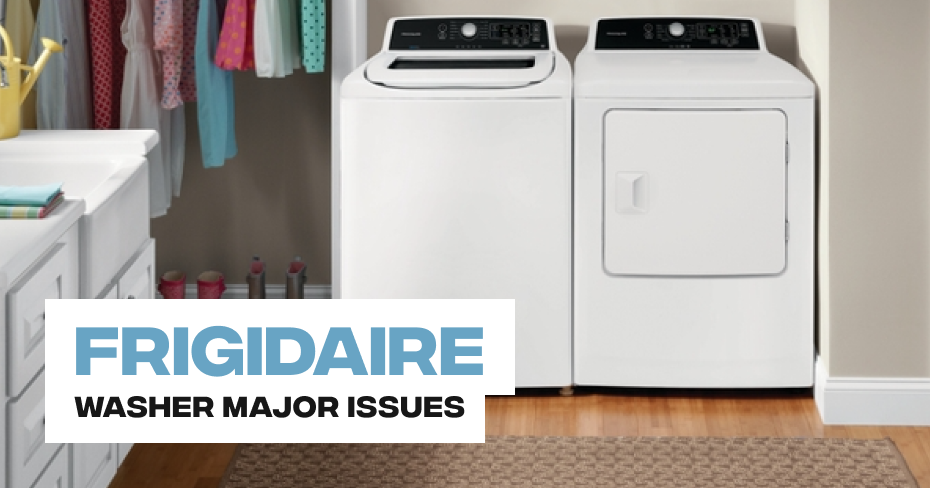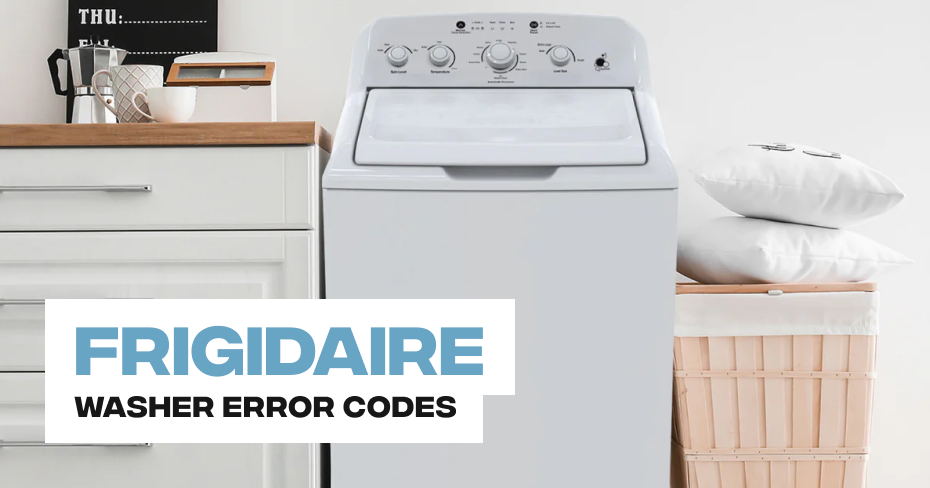Frigidaire Washer Spin Cycle Issues
The steps (highlighting the probable reasons your Frigidaire washer won’t spin clothes dry) include:
Step 1 – Look for possible power fault
Sometimes, the washing machine runs with a power fault, but the difference is that it doesn’t complete a spin cycle. And if the washer aborts the spinning mid-cycle, you’ll have wet laundry at the end.
In that case, consider these two issues:
- The power cord might be loose – If your washer’s power cord is not well plugged in, the washer won’t get adequate power to complete the cycle. So, you’ll likely have wet laundry.
- You are using an extension power cord – Unlike a wall socket, extension cords fail to deliver 100% of power to the washer. So, your Frigidaire washer may be unable to complete a spin cycle, resulting in the wet laundry.
Fix
Check the power cord to ensure it’s not loose. If it is, plug it in firmly.
Speaking of plugging the power cord, consider doing it into the wall outlet. Avoid extension cord unless you have a powerful and reliable option.
Step 2 – Inspect the washer; it could be out of balance
Your Frigidaire washer should rest on a uniform surface. If it’s not, there is always the risk of the clothes becoming unstable. And once they do, they cannot spin evenly. So, you’ll likely have some wet laundry.
Fix
Consider adjusting your washer’s leg leveler if the washer looks out of balance. If that’s not possible, move it to a more even surface.
Step 3 – Check the laundry too; it could also be out of balance
It takes even laundry in the drum for the Frigidaire washer to turn smoothly and spin-dry your clothes. If the clothes heap on one side, they may not spin at all, and if they do, the heaps will drip wet at the end of the cycle.
Fix
Check your laundry load to ensure it’s even. If it’s not, redistribute it evenly in the drum.
Step 4 – Recheck the laundry; it could be excess
Excessive laundry is just as serious as imbalanced laundry. So, if the laundry is not out of balance, confirm that it’s also not excess. Generally, you shouldn’t fill up your washer’s drum to the full.
If you do, it becomes hard for the clothes to spin, and if they do, they’ll not do it perfectly. Thus, some of the clothes will turn wet.
Fix
Reduce your wash laundry to about ¾ full if the washer is overloaded.
Step 5 – Test the washer’s lid/door for fault
The washer may spin with a faulty lid (top loader) or door (front loader) but incompletely. So, it’s worth testing them. In particular, check the following:
- Faulty switch – A broken or malfunctioning lid switch prevents your top-loading Frigidaire washer from completing the spin cycle. Thus, it could be why your washer won’t spin dry the clothes.
- Faulty latch – A faulty latch, just like the lid switch, hampers the Frigidaire front loader from completing the spin cycle. That’s because the washer door is unable to close correctly.
Fix
Using a multimeter, test the lid switch or door latch for continuity. If you don’t get any reading, replace them.
Step 6 – See if there’s excessive Sudsing (suds formation)
Putting too much washing detergent in the Frigidaire washing machine doesn’t help. It creates soapy clothes which are likely to drip wet.
The soap contributes to what we call suds lock, which is when soapy bubbles hold extra air pockets, which slow down the spinning and wets the clothes.
Fix
Avoid putting too much detergent in the washing machine. And if you have a front loader or HE Frigidaire washer, don’t use non-HE detergents as they are too soapy. Use HE detergents instead.
Step 7 – Look at your washer’s drainage
Typically, bad drainage equals bad spinning, and bad spinning equals wet clothes. So, you cannot overlook the drainage when your washing machine doesn’t spin your clothes dry.
Overall, here are the drainage issues that could cause your Frigidaire washer not to turn the laundry dry:
- Blocked drain hose – The drain hose clogs by dirt or debris build-up or by kinking (twisting). And once that happens, the washer’s wastewater cannot drain, and a part of it back-siphons to wet your clothes.
- Clogged drain filter – Wastewater from your washing machine can only drain if there are no obstructions on the drain filter. Sadly, the drain filter sometimes clogs with dirt to hinder water flow, soaking the laundry in the tub.
- Dirty drain pump – The drain pump finds it difficult to pump out the washer’s wastewater when it’s too messy. So, there’s always the risk of the drain water siphoning back into the tub.
- Drain pump malfunctioning – A malfunctioning drain pump cannot pump out the washer’s wastewater leaving the water in the tub to wet the clothes.
- Wrong drain pipe height – The washer drain pipe height shouldn’t exceed 8 feet. If it does, the drain pump will have difficulty pumping out the drain water.
Fix
Consider cleaning the drain hose, drain filter and even pump with Affresh drain cleaner to reduce the dirt clogging. If the drain hose is twisted/kinked, straighten it out to eliminate the kinks.
And if the drain pump is damaged, replace it. Meanwhile, keep the washer’s drain hose pumping height under 8 feet.
Step 8 – Consider a potential spinning problem or weak spin
Having mentioned bad spinning under step 7; it’s essential to highlight several other causes which interfere with the washer spinning.
If the washer’s spin is weak, it won’t complete the cycle, and thus the chances of having wet clothes are much higher. As far as weak spinning goes, watch out for any of these causes:
- Wrong spin cycle – There is always the chance that you’ll end up with wet clothes if you select no spin or low spin for the bulky load. The same goes for using gentle/delicate settings on bulky garments.
- Component malfunction (washer belt, motor coupling, or clutch) – If the washer belt is loose, stretched, or cracked, it won’t spin the drum properly. The same goes for a defective motor coupling or clutch.
Fix
Ensure you pick the right spin for your clothes. Choose a fast spin for your washing machine when handling a bulky load. Additionally, replace the washer belt, motor coupling, or clutch if any is faulty.
Step 9 – Observe the water inlet valve; it could be loose and leaky
The last check is the water inlet valve. If this component is loosely fitted, water will leak internally into the drum, soaking your clothes wet.
Fix
Tighten the water inlet valve if it’s too loose. If it looks faulty, replace it.
Frigidaire Front Load Washer Not Spinning Clothes Dry
Several reasons could explain why a front load washer is not spinning dry clothes. The commonest include:
The washer’s door latch could be faulty, hampering the door from closing well and the washer from turning optimally:
- You might be using an excess detergent
- The load could be extra, bulky, or out of balance
- The washer could be out of balance
- Potentially bad drainage
Frigidaire Top Load Washer Not Spinning Clothes Dry
As far as a Frigidaire top-loader filing to spin-dry clothes go, here are the most likely reasons:
- A faulty lid switch that’s preventing the lid from shutting well and the washer from spinning correctly
- Laundry imbalance or clothes jamming
- Defective washer belt that won’t turn the washer correctly
- Faulty motor coupling
- Washer imbalance
Frigidaire Affinity Washer Not Spinning Clothes Dry
Since a Frigidaire affinity is a front loader, its reason for not spinning clothes dry could be any of these:
- Washer or laundry imbalance
- Excess detergent, mostly non-HE (non-high-efficiency)
- Bad drainage due to pump malfunctioning or drain clogging
- Faulty door latch
Closing Remarks on Frigidaire Washer Not Spinning Clothes Dry
Now you know what to check when your Frigidaire washer won’t spin-dry your clothes. With the above 9-step guide, you wouldn’t need anyone to help you troubleshoot the washing machine when it develops a problem. But if you are unsuccessful with the nine steps, talk to Frigidaire or any washing machine expert.


